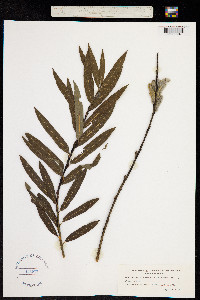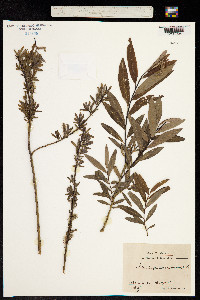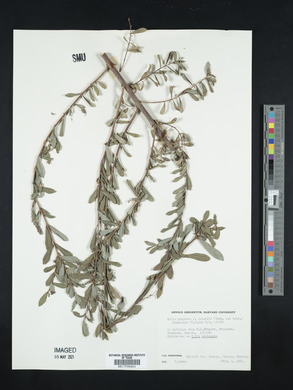Salix purpurea
|
|
|
|
Family: Salicaceae
Purple Willow
[Salix purpurea f. sericea (Ser.) Wimm., moreSalix purpurea f. styligera Wimm., Salix purpurea var. angustifolia Illitsch., Salix purpurea var. gracilis Gren. & Godr.] |
Plants sometimes forming clones by stem fragmentation. Stems: branches (sometimes ± brittle at base), yellow-brown or olive-brown, not or weakly glaucous, glabrous; branchlets yellow-brown or olive-brown, violet tinged, glabrous. Leaves (sometimes opposite or subopposite); stipules absent; petiole shallowly grooved adaxially, 2-7 mm, glabrous adaxially; largest medial blade lorate, narrowly oblong, narrowly oblanceolate, oblanceolate, 35-77 × 5-20 mm, base convex or rounded, margins strongly revolute, entire or serrulate, apex acute, acuminate, or convex, abaxial surface glaucous, glabrous, adaxial dull to sublustrous, glabrous; proximal blade margins entire; juvenile blade yellowish green or reddish, glabrous or sparsely pubescent abaxially, hairs white, sometimes also ferruginous. Catkins flowering before leaves emerge, (subopposite, recurved); staminate stout or subglobose, 25-33 × 6-10 mm, flowering branchlet 0 mm; pistillate densely flowered, slender or stout, 13.5-34.5(-35 in fruit) × 3-7 mm, flowering branchlet 0.5-3 mm; floral bract black or bicolor, 0.8-1.6 mm, apex rounded, abaxially hairy, hairs straight or wavy. Staminate flowers: adaxial nectary oblong, square, or ovate, 0.4-0.8 mm; filaments connate; anthers (distinct), purple turning yellow, ellipsoid or globose, 0.4-0.5 mm. Pistillate flowers: adaxial nectary ovate, 0.3-0.7 mm; ovary obturbinate, beak gradually tapering to styles; ovules 6 per ovary; styles 0.2-0.3 mm. Capsules 2.5-5 mm. 2n = 38. Flowering mid Mar-mid May. Floodplains and shores, fens, swamps, alder thickets, sandy and limestone beaches, low dunes; 0-900 m; introduced; N.B., Nfld. and Labr. (Nfld.), N.S., Ont., P.E.I., Que.; Calif., Conn., Del., D.C., Ga., Ill., Iowa, Ky., Maine, Md., Mass., Mich., Minn., Mo., N.H., N.Y., N.C., Ohio, Oreg., Pa., R.I., Utah, Vt., Va., W.Va., Wis.; Europe. Salix purpurea occurrence in Ohio is based on information from T. S. Cooperrider (pers. comm.).
Shrub 2.5 - 5 m tall Leaves: alternate, sometimes opposite, on 4 - 8.5 mm long leafstalks, shiny dark blue-green above, pale or waxy-looking beneath, 5 - 10 cm long, 3 mm - 2.5 cm wide, lance-shaped with a tapering base and pointed tip, toothed near the tip, and sometimes slightly hairy. Leaves turn blackish when dried. Flowers: either male or female, borne on separate trees (dioecious) in narrow, cylindrical catkins. The catkin is hairy and grows on a short, leafy stalk. Female catkin to 2 cm long with blackish scales. Ovary hairy. Male catkin 1.5 - 2.5 cm long with blackish scales. Stamens two, with reddish anthers (the filaments and anthers are often fused). Fruit: a capsule, in elongated clusters, stalkless, light brown, 3 - 4 mm long, flask-shaped, and slightly hairy. Seeds have long, white, silky hairs attached. Twigs: slender, stout, and purplish, becoming light gray or olive-gray. Buds: purplish, small, pointed, and appressed. Form: rounded and dense. Similar species: In the Chicago Region, Salix purpurea differs from all other willows by having many leaves that are opposite or subopposite. The other willows have alternate leaves. Flowering: April to May, before the leaves Habitat and ecology: Introduced from Eurasia. Cultivated as an ornamental, and occasionally found as an escape in moist soil. Occurence in the Chicago region: non-native Notes: The stems have been used in basket making. Etymology: Salix is the Latin word for willow. Purpurea means purple. Author: The Morton Arboretum Many-stemmed shrub 1-2.5 m; twigs slender, greenish- yellow or rarely purplish, glabrous; stipules none; lvs short-petioled, mostly linear-oblanceolate or spatulate or linear, 4-7(-10) cm נ7-14(18) mm, entire below, irregularly serrate toward the tip, finely raised-reticulate on both sides, with a purplish cast, glaucescent beneath, glabrous, at least some of those towards the ends of the twigs subopposite; catkins precocious, 2-3.5 cm נ5-8 mm, sessile, bracteate, subopposite; scales broadly obovate, blackish, becoming glabrate; stamens 2 but the filaments and often the anthers united; frs ovoid-conic, 3-4 mm, obtuse, sessile, short-hairy; style 0.1-0.2 mm; 2n=38. Native of Europe, sparingly escaped from cult. in our range. Gleason, Henry A. & Cronquist, Arthur J. 1991. Manual of vascular plants of northeastern United States and adjacent Canada. lxxv + 910 pp. ©The New York Botanical Garden. All rights reserved. Used by permission. From Flora of Indiana (1940) by Charles C. Deam Indiana Coefficient of Conservatism: C = null, non-native Wetland Indicator Status: FACW |











































































